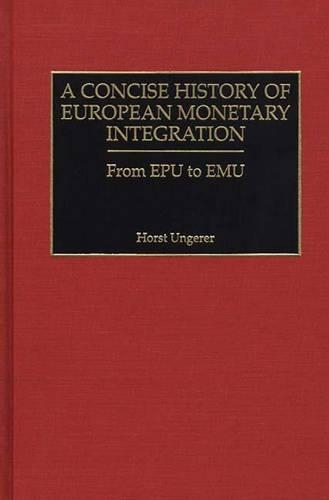
A Concise History of European Monetary Integration: From EPU to EMU
(Hardback)
Publishing Details
A Concise History of European Monetary Integration: From EPU to EMU
By (Author) Horst Ungerer
Bloomsbury Publishing PLC
Praeger Publishers Inc
16th July 1997
United States
Classifications
Tertiary Education
Non Fiction
332.494
Physical Properties
Hardback
352
Width 156mm, Height 235mm
624g
Description
Ungerer provides a comprehensive, yet concise and accessible history of European monetary integration over the past 50 years, from the European Payments Union (EPU) to the realization of economic and monetary union (EMU) as mapped out in the Maastricht Treaty. Monetary policy and institutional developments in the quest for European integration are examined against their political background and placed in the broader context of international monetary developments, in particular those concerning the US dollar. Ungerer reviews the economic and monetary policy provisions of the European Economic Community (EEC) Treaty and discusses early proposals for closer monetary policy cooperation and plans for economic monetary union, including the Werner report. The features and evolution of the common European exchange rate systems - the "snake" and in particular, the European Monetary System - are examined. The author discusses the negotiations leading to and the provisions of the Maastricht Treaty and also analyzes benefits and costs of EMU. The crises in the European Monetary Union 1992-1993 cast doubt on whether EMU was still a realistic goal. However, Ungerer shows that the political determination to move on remained undiminished. He discusses the extensive preparations for the creation of a European Central Bank and the single European currency, the "euro", and the efforts to ensure its stability. Finally, the book provides an outlook on the main monetary policy issues that confront the European Union and the challenges arising from a strengthening of the political structure of the European Union and the membership applications of many countries in the Mediterranean and in Central and Eastern Europe.
Reviews
"[This book] is not only concise but very thorough. It covers a half century of European economic and monetary history during which the integration process was driven by both economic and political motivations....This book will no doubt remain a standard reference work for anyone interested in the economic and monetary history of Western Europe since World War II."-Robert Solomon Guest Scholar The Brookings Institution
"Soon we will be witnesses of the creation of a European currency, and many of us wonder about the chances of such a bold and unprecedented move. In this situation [this] book comes just in time. It shows that the roots of this project date back to the early beginnings of European co-operation after WW II. Being...a close witness and a player in this historical process, [Ungerer's] record of its various stages, where dead-ends were followed by creative new initiatives, is illuminating reading. I cannot imagine that anyone taking an academic or professional interest in the new 'Euro' would like to miss this book, which shows how successful monetary engineering has now brought a grand political design within reach."-Dr. Gunther Schleiminger retired General Director Bank for International Settlements
"This work will be an indispensable tool for those who wish to understand EMU."-Jacques de Larosiere, President European Bank for Reconstruction and Development
Ungerer's goal is to present students, scholars, and the general public with a comprehensive account of the decelopment of European monetary integration since 1945. His effort is unusually successful. Indeed, he also provides additional background information that will be helpful to general readers.... The historical account of European monetary institutions since 1945 includes well-informed commentaries on all the major stages of development up to the end of 1996, and concludes with a discussion about the prospects for the achievement of an ever closer union in Europe in the years ahead... Ungerer asserts that a single European currency has always been viewed as a key to full economic integration and that management of such a currency would require the merging of some sovereign powers by the nations involved. This sets the scene for readers wishing to follow the debates that will continue as Europe proceeds along the timetable that may lead to the introduction of a single currency in 1999.... Recommended for international economics, politics, and business collections.-Choice
"Ungerer's goal is to present students, scholars, and the general public with a comprehensive account of the decelopment of European monetary integration since 1945. His effort is unusually successful. Indeed, he also provides additional background information that will be helpful to general readers.... The historical account of European monetary institutions since 1945 includes well-informed commentaries on all the major stages of development up to the end of 1996, and concludes with a discussion about the prospects for the achievement of an ever closer union in Europe in the years ahead... Ungerer asserts that a single European currency has always been viewed as a key to full economic integration and that management of such a currency would require the merging of some sovereign powers by the nations involved. This sets the scene for readers wishing to follow the debates that will continue as Europe proceeds along the timetable that may lead to the introduction of a single currency in 1999.... Recommended for international economics, politics, and business collections."-Choice
Author Bio
HORST UNGERER is guest lecturer at universities in Europe and the United States. He has had a distinguished career, spanning more than three decades, in central banking and international finance. Ungerer was a senior official in the Deutsche Bundesbank and the International Monetary Fund, from where he retired in 1991 as Assistant Director in the European Department. Ungerer is author and coauthor of many papers on European monetary policy issues published in the United States and Europe.
